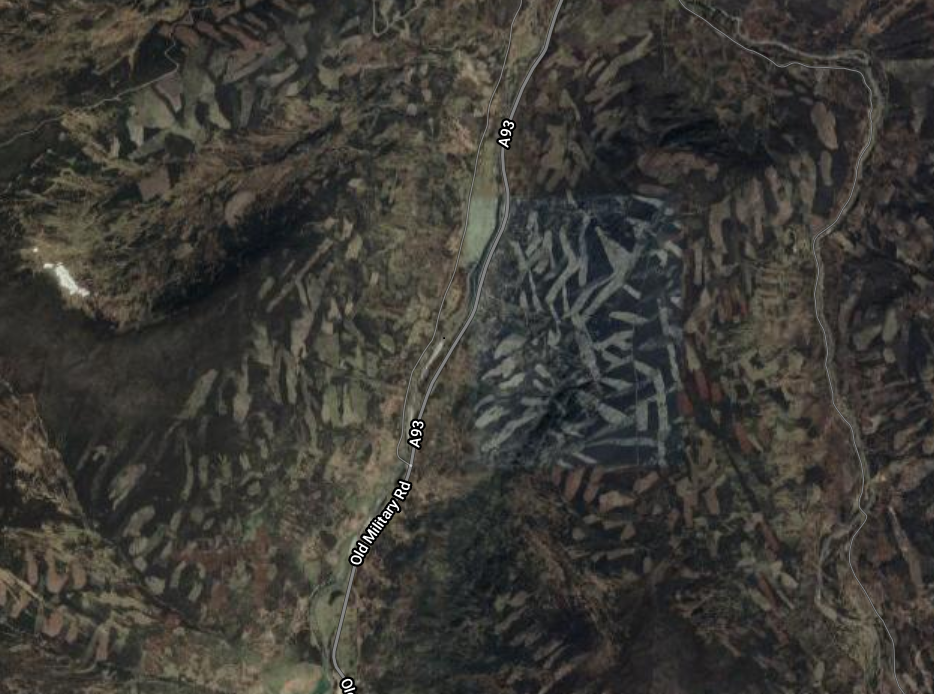
Just over a month ago the Cairngorms National Park Authority announced (see here) that the Invercauld Estate had left the East Cairngorms Moorland Partnership “following the discovery of a poisoned golden eagle on their land.” This post takes a look at the implications for the Cairngorms National Park Authority and for land reform more generally.
The news release was unclear about whether Invercauld had decided to resign or whether it had been expelled from the ECMP. Unlike almost any other news release you will ever read, no-one was quoted, not even the Chief Executive of the CNPA. The unwritten rule of landownership is that whatever your neighbours get up to, thou shalt not criticise them in public. The owners of grouse moors have been so successful in influencing our Public Authorities that that rotten ethos is now embedded in how the CNPA works. There is no better demonstration of the hypocrisy and double standards than Prince Charles who, having spent much of the last year warning people about wildlife collapse around the world (see here for example), has been silent about wildlife crime on Balmoral’s doorstep.
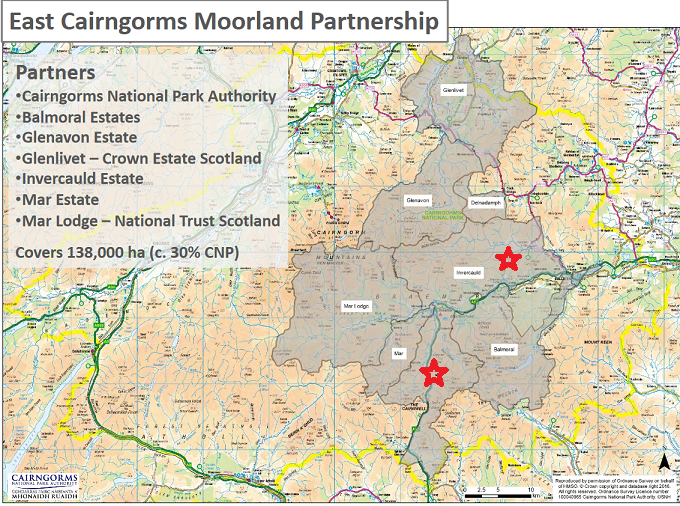
The departure/expulsion of the Invercauld Estate has however created a gaping hole in the CNPA’s stated strategy to deliver landscape scale conservation in the National Park. The ECMP has, since 2015, been the CNPA’s main vehicle for trying to make grouse moor management in the National Park more “conservation friendly”. For example, without Invercauld, Balmoral is now isolated geographically from the rest of the “partnership” so there can be no join up of conservation initiatives. Reason enough, one might think, for the CNPA to review its approach to partnership working as a matter of urgency.
Yet in the papers for the CNPA Board which met on Friday 4th June, I could find only two references to what had happened. The first was in the normally informative Chief Executive’s report (see here), but in the section reporting on “corporate communications” not conservation matters:
“These include our response to the golden eagle poisoning on Invercauld Estate –and the subsequent departure of Invercauld from the East Cairngorms Moorland Partnership”
The second was in the Cairngorms Nature Action Plan mid-term report, but this did not even name Invercauld:
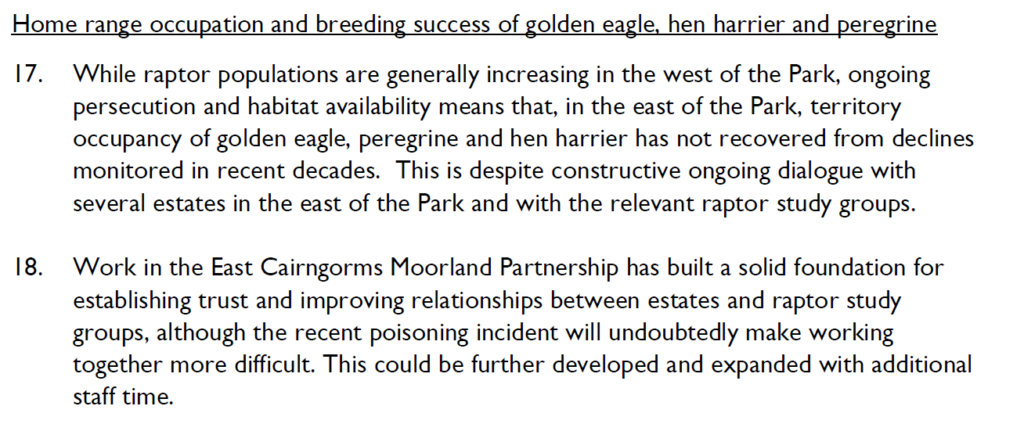
Given what has happened at Invercauld this is, quite frankly, deluded. How can there be trust while raptors continue to disappear? Rather than “solid foundations” it would be closer to the truth to say that the poisoning of the eagle shows that the ECMP has been built built on sand.
Despite Invercauld’s departure from the ECMP, progress on developing sustainable moorland management is reported in the Nature Action Plan, under the traffic light evaluation system so beloved by our bureaucracies, as amber not red:
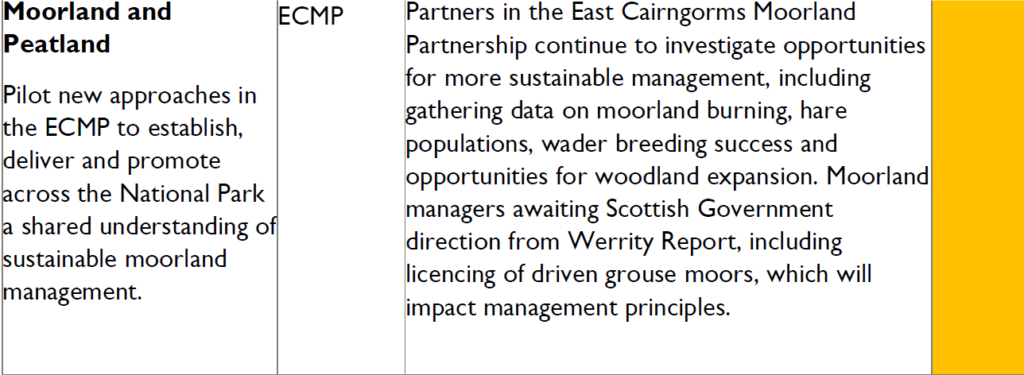 (
(
Five and a half years after being created, the best that can be said is the ECMP is continuing “to investigating opportunities for more sustainable management” and is awaiting further action from the Scottish Government.
As an indication of the sort of work that is being done the Board papers report:
“Balmoral estate, and other landowners in Deeside, are gathering stakeholder opinion on capercaillie issues to inform a questionnaire for distribution later this summer.”
As far as I am aware, capercaillie are now once again practically extinct on Deeside, so what this will achieve is unclear. But it sounds good and helps to distract the public from the ongoing conservation failures at Balmoral and the surrounding estates, most notably the destruction of the woodland habitat that capercaillie require through the maintenance of high deer numbers and the use of muirburn for sporting purposes. It is well past time that the CNPA reported openly on what the ECMP has actually achieved.
Unfortunately, there is no video recording on the CNPA website of the Board Meeting. I have been unable to find out therefore if Board Members questioned what the ECMP has achieved or discussed how they might promote conservation now Invercauld is no longer part of the partnership. That both the Board and the Senior Management Team should have done so is demonstrated by a paper on governance considered at an additional meeting of the CNPA Board held on 28th May (see here):

This raises the question of whether the ECMP been delivering strategic outcomers against agreed performance indicators and, if so, what are these performance indicators (apart from the elimination of raptor persecution which we know has failed)?
There was another comment in the Chief Executive’s report which indicates that other aspects of partnership working with Invercauld had also failed:
“Peatland: A project on Invercauld Estate is not going ahead due to difficulties in agreeing reasonable access to carry out the work.”
So why was there no officers report to the CNPA Board meeting analysing what the ECMP has achieved, what has gone wrong and putting forward options for the future? Or is the CNPA now just going to try and pretend that Invercauld, which comprises almost a tenth of the National Park, does not exist?
How much public money has been wasted at Invercauld?
How much the CNPA and Nature Scot have spent on peatland restoration on Invercauld and other estates in the National Park does not appear to be public, a basic failure in transparency (I will ask). But the Scottish Rural Payments database shows that in 2019 Invercauld received £162,493 for forest expansion:
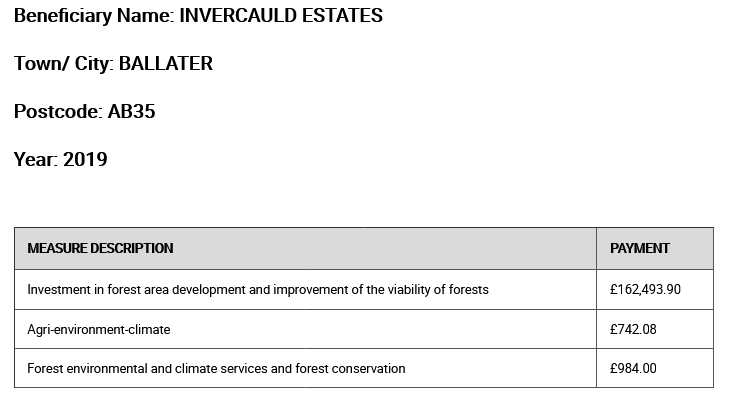
In effect what appears to have been happening is that our public authorities have been trying to incentivise – bribe might be a better word? – estates like Invercauld to undertake small conservation projects while allowing them to continue to burn vast areas of moorland for grouse shooting (just take a look on google earth), a practice that destroys woodland and peat formation.
What needs to happen?
The CNPA Board and the Scottish Government both need to recognise that the voluntary approach to improving moorland management has failed. Instead of trying to cover up what has gone wrong, they need now to publish a comprehensive report of what the ECMP had actually changed in the last five years. My suspicion, based on what I have seen on the ground, is that in much of the area – with the notable exception of Mar Lodge Estate which is managed by the National Trust for Scotland – the management of grouse moors has continued to intensify over the last five years. The problems, including the collapse of wildlife, are likely to have got worse, not better. If the CNPA dispute that, they should publish information to show what has changed.
The partnership failure has implications both for the CNPA and the Scottish Government’s implementation of the recommendations of the Werritty Review of grouse moor management. It cannot be acceptable that the CNPA, which has a statutory duty to promote conservation, allows Invercauld to ignore its conservation agenda, destroy the land through burning and allow its staff to eradicate raptors. It should now, as I have been arguing for over five years on parkswatch (see here for example), start a consultation on how it could use its conservation making powers (and ask NatureScot to do the same by creating Nature Conservation Orders) to force Invercauld and other sporting estates which are unwilling to co-operate to change.
The Scottish Government meantime should not just be aiming to implement the recommendations of the Werritty Review but to strengthen them to deal with estates, like Invercauld, that have shown they won’t do so voluntarily. Unfortunately, the latest indications are that the Scottish Government is still dragging its feet on the reform of grouse moors (see here). Unless there is considerable pressure from the public, that is unlikely to change.
Parkswatch has argued for some time that the Royal Family provides one of the main blocks to conservation in the Cairngorms National Park, whether this is the high deer numbers that are preventing forest regeneration at Balmoral (see here) or the intensive grouse moor management at Princes Charles’ estate at Delnadamph (see here). Both estates are in the ECMP. I was very pleased therefore that others have now decided it is time to call the Royal Family to account, A petition (see here) calling on them to rewild their land, to match their words with actions, has now reached over 66,000 signatures. If you haven’t done so, please consider adding your name and, if you have time, consider writing to your locally elected representatives asking them to call on the Royal Family to take action before the Climate Change conference in Glasgow this Autumn.
Excellent article Nick. I note the statement from CNPA that “Work in the East Cairngorms Moorland Partnership has built a solid foundation for establishing trust and improving relationships between estates and raptor study groups.”
From my point of view that is not true. I wrote an article on this blog about finding baited rabbit traps on Invercauld that had caught, and seriously injured, a gull leading to it having to be put down (this incident occurred after the establishment of ECMP). I was monitoring merlins at the time for the North East Scotland Raptor Study Group. The traps caused the death of a gull, but could have killed young merlins that fledged into the area where the traps were set, or other species of raptor hunting in the area such as golden eagle, yet Invercauld was allowed to remain a member of the ECMP. It seems that illegally set traps being found on an estate is OK as long as it’s only a gull that is dead, but if you’re suspected of killing a golden eagle you’re on your own. It also feels like the decision on whether you can remain in CNPA partnerships or not might be related to the PR implications of the alleged crime. This is necessarily conjecture as we are not privy to the truth as to whether Invercauld jumped for their own reasons or were pushed from the partnership. The lack of transparency is on trend.
I personally did not see the fruits of ECMPs labours in terms of establishing trust and improving relations with Invercauld. Indeed, after I reported the gull incident the hassle caused to me by their head keeper increased.
We need to have some sympathy for the officials and board members of every public body, as they near retirement or the end of their term of appointment. Many await the prospect of their names appearing in the Queen’s Honours List. Nobody with such aspirations dare criticise what is happening on Balmoral or take the appropriate action. Meanwhile, as a climate and biodiversity disaster awaits us all, such officials and members concentrate on re-arranging the deckchairs as the ship sails towards the melting iceberg.
Partnership approaches work well when the issues being dealt with are not very controversial or are not issues that have already reached crisis point. With both climate and nature we reached a crisis point years ago. Strong leadership that has the power (and is willing) to administer sticks as well as carrots is required.
Let me introduce a word of warning in regards to Mar Lodge.
A number of years ago a gamekeeper had assaulted me adjacant to a grouse moor. He was in a land rover at the time had both a shotgun and a firearm visible. The police investigated and issued him with a warning to stop harrassing me. A few days later i was walking with my wife when he drew up before me in his land rover and began to abuse and insult me. He saw my wife switch the record button on our camera and thus knew he was being taped .. at least audibly if not visibly.
i contacted the police and once more they investigated — with the same results … he was to be warned. They, the police, made no reply when I asked why, after the first warning, he was not being charged with a criminal offence. I did not receive a reply on this occasion.
Imagine my surprise when I heard that he had left the estate on which he was working and was now employed as a beat keeper on Mar Lodge. Now, the factor of the estate who has recently retired and whose name has appeared regularly in this blog, had ties to NTS Mar Lodge and various deer organisations and was employed by a Peer of the realm.
I find it difficult to understand why, in these circumstances, with the man under investigation by Tayside Police at the time and had just received a warning for threatening behaviour, would be hired by Mar Lodge as they must have known the situation.
Not only is he still employed at Mar Lodge but is now a Head Keeper there.
i have no confidence at all that Mar Lodge is a true partner in the Rewilding Project currently being undertaken and see the estate as a Trojan Horse parked right in the center of what they might see as “the enemy camp” as the unfettered rhetoric of their foot soldiers remains insulting and abusive as are the briefings of C4PMC which many see as a astro-turf entity by the same set of interests which appear to have undue infleunce in Mar Lodge.
If CNPA continues to pretend that the ECMP is producing any meaningful results, then we have yet another example of our Park Authority being great with words and useless on actions. However, even the words are beginning to fail. One look at the CNPA website on the Partnership Plan 2017-2022, shows that their latest update is an annual review for 2018-19. Yes, I know they will blame Covid-19, but that shouldn’t have stopped them discussion updates with partners and walking the ground – or is even the CNPA finding it difficult to write any positive gloss on their Partnership Plan?
Time for trying to ‘bribe’ and cosy up to the ECMP members has long run out, especially with the Invercauld Estate withdrawing to do their own thing. Our CNPA Board (and the same issue applies to LLTNPA) need to be advocates for conservation change and be visibly lobbying our insular Scottish Government to take urgent legislative action to implement the Werritty Report. The Park Boards could even combine to recommend that both our National Parks are given the necessary legislative powers to introduce pilot actions, like limiting muirburn and licensing grouse shooting. When have either of our National Parks shown themselves to be advocates of environmental change and visibly lobbied hard to our Government for changes? I’m not aware of any examples. Instead they have habitually cosied up to our Government in the hope of increased handouts.